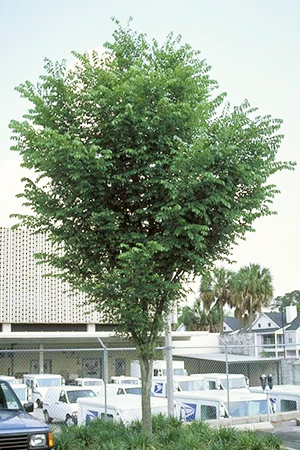Florida Elm

A Florida elm growing in a parking lot.
Photo: Edward Gilman, UF/IFAS.
Florida elm (Ulmus americana) is great choice when choosing a long-living shade tree. This elegant, deciduous tree dazzles in autumn with rich, golden yellow foliage. As an added bonus, Florida elm is moderately tolerant of drought and salt spray. The wood of the Florida elm is also is very useful; it's used for making furniture, and indigenous peoples made canoes out of it.
Characteristics
Florida elm is a tall, straight-trunked tree with an elegant vase-shaped crown. It typically has one trunk and features a symmetrical canopy shape. Florida elm is fast growing and can reach 60 to 80 feet tall and spread 50 to 60 feet wide.
The six-inch-long, deciduous leaves are dark green throughout the year, fading to yellow before dropping in fall. In the spring, it produces inconspicuous small green flowers. Following the flowers are green, wafer-like seedpods that are popular with birds and other wildlife.
Planting and Care
Florida elm grows in full sun or light shade in zones 8 to 10a. Be aware that if you suffer from pollen allergies, elms are reported to produce allergenic pollen.
When selecting a planting site for your tree, remember that all elms are susceptible to breakage in storms due to frequent formation of bark inclusions in the crotches of co-dominant stems where there is a narrow angle union; this causes weakness in the tree's structure.
Another consideration to take into account when selecting a planting location is the copious amounts of seeds that fall; this may create a problem on hard surfaces. Additionally, trees have extensive but shallow root systems.
A regular pruning program is required on elms in order to develop good structure after planted in the landscape. Trees need to be pruned when young to create a single dominant leader by shortening aggressive main branches with reduction cuts. It’s best to prune elms only in the dormant season to help avoid the spread of disease. While Dutch elm disease has killed many elms in the northern parts of the country, it has not yet been detected in Florida. However, arborists watch elms closely for the symptoms so any outbreak can be quickly quarantined and controlled.

This elm has co-dominant branches, which increases its chances of splitting. Photo: William Jacobi; Colorado State University; Bugwood.org
UF/IFAS Sites
UF/IFAS Publications
Also on Gardening Solutions

